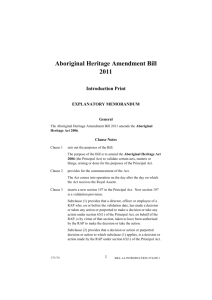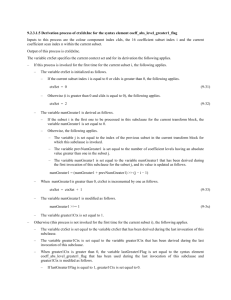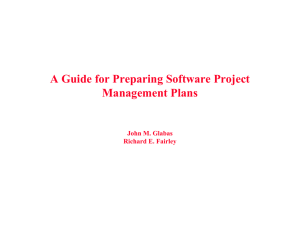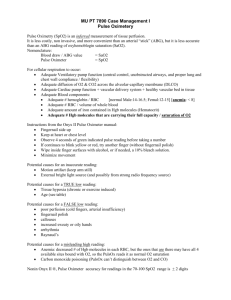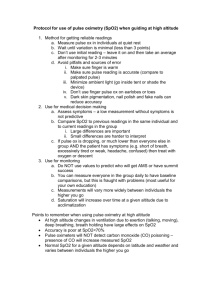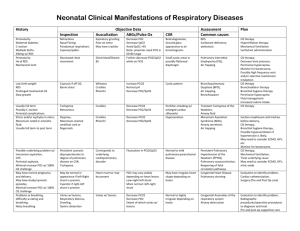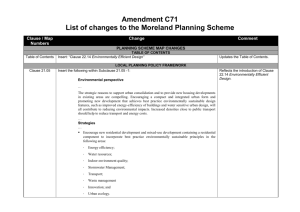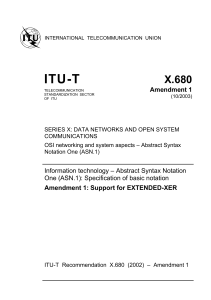Managerial process plans section 5 - cs633group6
advertisement
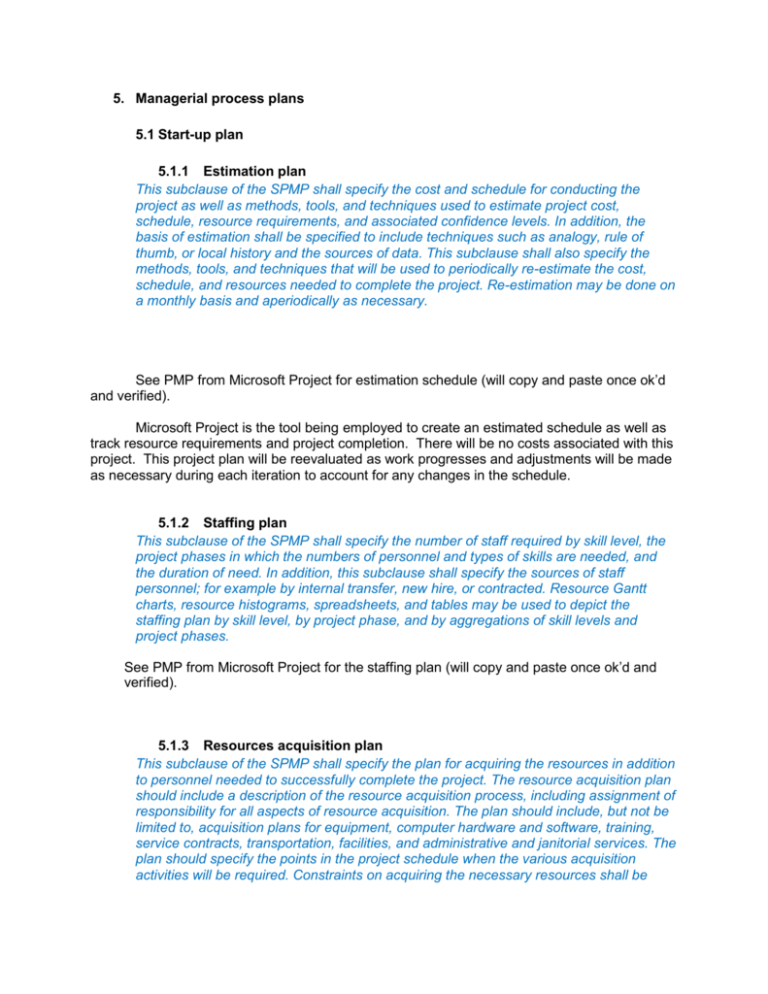
5. Managerial process plans 5.1 Start-up plan 5.1.1 Estimation plan This subclause of the SPMP shall specify the cost and schedule for conducting the project as well as methods, tools, and techniques used to estimate project cost, schedule, resource requirements, and associated confidence levels. In addition, the basis of estimation shall be specified to include techniques such as analogy, rule of thumb, or local history and the sources of data. This subclause shall also specify the methods, tools, and techniques that will be used to periodically re-estimate the cost, schedule, and resources needed to complete the project. Re-estimation may be done on a monthly basis and aperiodically as necessary. See PMP from Microsoft Project for estimation schedule (will copy and paste once ok’d and verified). Microsoft Project is the tool being employed to create an estimated schedule as well as track resource requirements and project completion. There will be no costs associated with this project. This project plan will be reevaluated as work progresses and adjustments will be made as necessary during each iteration to account for any changes in the schedule. 5.1.2 Staffing plan This subclause of the SPMP shall specify the number of staff required by skill level, the project phases in which the numbers of personnel and types of skills are needed, and the duration of need. In addition, this subclause shall specify the sources of staff personnel; for example by internal transfer, new hire, or contracted. Resource Gantt charts, resource histograms, spreadsheets, and tables may be used to depict the staffing plan by skill level, by project phase, and by aggregations of skill levels and project phases. See PMP from Microsoft Project for the staffing plan (will copy and paste once ok’d and verified). 5.1.3 Resources acquisition plan This subclause of the SPMP shall specify the plan for acquiring the resources in addition to personnel needed to successfully complete the project. The resource acquisition plan should include a description of the resource acquisition process, including assignment of responsibility for all aspects of resource acquisition. The plan should include, but not be limited to, acquisition plans for equipment, computer hardware and software, training, service contracts, transportation, facilities, and administrative and janitorial services. The plan should specify the points in the project schedule when the various acquisition activities will be required. Constraints on acquiring the necessary resources shall be specified. This subclause may be expanded into additional subclauses of the form 5.1.3.x to accommodate acquisition plans for various types of resources to be acquired. No additional resources will need to be acquired in addition to personnel. 5.1.4 Project staff training plan This subclause of the SPMP shall specify the training needed to ensure that necessary skill levels in sufficient numbers are available to successfully conduct the software project. The training schedule shall include the types of training to be provided, numbers of personnel to be trained, entry and exit criteria for training, and the training method; for example, lectures, consultations, mentoring, or computer-assisted training. The training plan should include training as needed in both technical and managerial skills. No additional staff training will be necessary to complete this project. 5.2 Work plan See PMP from Microsoft Project for work plan (will copy and paste once ok’d and verified). 5.2.1 Work activities This subclause of the SPMP shall specify the various work activities to be performed in the software project. A work breakdown structure shall be used to depict the work activities and the relationships among work activities. Work activities should be decomposed to a level that exposes all project risk factors and allows accurate estimate of resource requirements and schedule duration for each work activity. Work packages should be used to specify, for each work activity, factors such as the necessary resources, estimated duration, work products to be produced, acceptance criteria for the work products, and predecessor and successor work activities. The level of decomposition for different work activities in the work breakdown structure may be different depending on factors such as the quality of the requirements, familiarity of the work, and novelty of the technology to be used. To execute the Iterative and Incremental GDD Process, we decided that each team member would be responsible for a specific phase and at the end of each iteration we would have a working prototype. Kevin would gather the requirements, Adriana would do the design, Haroon would do the implementation, Ahmed would do the testing and maintenance. We feel that this particular process best fits the project requirements by offering an iterative approach that is not overly complicated. We can move between phases with each iteration of the project taking between 1 to 2 weeks (or as necessary) for completion. Because of the limited time frame we are on, we have to compress a number of elements that ordinarily may take a week or longer. We anticipate that the requirements phase of each iteration will take 3 to 4 days as we analyze and either accept or reject requests as well as implement older project ideas. The design phase where we tweak design characteristics and create mockups will take up to 2 days. The coding phase will occupy another day or two. Depending where we are in the project, the testing phase will occupy a greater amount of time. This is to allow for thorough testing of the application as it is closer final product. 5.2.2 Schedule allocation This subclause of the SPMP shall provide scheduling relationships among work activities in a manner that depicts the time-sequencing constraints and illustrates opportunities for concurrent work activities. Any constraints on scheduling of particular work activities caused by factors external to the project shall be indicated in the work activity schedule. The schedule should include frequent milestones that can be assessed for achievement using objective indicators to assess the scope and quality of work products completed at those milestones. Techniques for depicting schedule relationships may include milestone charts, activity lists, activity Gantt charts, activity networks, critical path networks, and PERT. See PMP from Microsoft Project for the schedule (will copy and paste once ok’d and verified). 5.2.3 Resources allocation This subclause of the SPMP shall provide a detailed itemization of the resources allocated to each major work activity in the project work breakdown structure. Resources shall include the numbers and required skill levels of personnel for each work activity. Resource allocation may include, as appropriate, personnel by skill level and factors such as computing resources, software tools, special testing and simulation facilities, and administrative support. A separate line item should be provided for each type of resource for each work activity. A summary of resource requirements for the various work activities should be collected from the work packages of the work breakdown structure and presented in tabular form. See PMP from Microsoft Project for resource allocation (will copy and paste once ok’d and verified). Aside from personnel, there are no further resources that must be acquired to implement this project. 5.2.4 Budget allocation This subclause of the SPMP shall provide a detailed breakdown of necessary resource budgets for each of the major work activities in the work breakdown structure. The activity budget shall include the estimated cost for activity personnel and may include, as appropriate, costs for factors such as travel, meetings, computing resources, software tools, special testing and simulation facilities, and administrative support. A separate line item shall be provided for each type of resource in each activity budget. The work activity budget may be developed using a spreadsheet and presented in tabular form. There are no further resources that need be acquired to implement this project. Furthermore, there are no other costs for any other factors. 5.3 Control plan 5.3.1 Requirements control plan This subclause of the SPMP shall specify the control mechanisms for measuring, reporting, and controlling changes to the product requirements. This subclause shall also specify the mechanisms to be used in assessing the impact of requirements changes on product scope and quality, and the impacts of requirements changes on project schedule, budget, resources, and risk factors. Configuration management mechanisms shall include change control procedures and a change control board. Techniques that may be used for requirements control include traceability, prototyping and modeling, impact analysis, and reviews. (Rough draft – feel free to change it. I’m not sure if we should write all these plans as if this document was created at the beginning of the project or with what we have done up to this point and plan to do next) The first set of detailed requirements were triaged in must do, optional or neither of the above categories. The must do requirements were implemented within the first iteration. Most of the optional requirements will be distributed for implementation in future iterations. Since new requirements and/or enhancements are being identified during the testing phase, they will be prioritized for implementation. Requirements gathering is collected and documented in Microsoft Word and then posted on the project Wiki for record keeping and collaboration. 5.3.2 Schedule control plan This subclause of the SPMP shall specify the control mechanisms to be used to measure the progress of work completed at the major and minor project milestones, to compare actual progress to planned progress, and to implement corrective action when actual progress does not conform to planned progress. The schedule control plan shall specify the methods and tools that will be used to measure and control schedule progress. Achievement of schedule milestones should be assessed using objective criteria to measure the scope and quality of work products completed at each milestone. Microsoft Project will provide a comprehensive assessment for our records indicating project completion times. 5.3.3 Budget control plan This subclause of the SPMP shall specify the control mechanisms to be used to measure the cost of work completed, compare planned cost to budgeted cost, and implement corrective action when actual cost does not conform to budgeted cost. The budget control plan shall specify the intervals at which cost reporting will be done and the methods and tools that will be used to manage the budget. The budget plan should include frequent milestones that can be assessed for achievement using objective indicators to assess the scope and quality of work products completed at those milestones. A mechanism such as earned value tracking should be used to report the budget and schedule plan, schedule progress, and the cost of work completed. Because no additional cost or resource items are being implemented, a budget control plan has not been implemented. 5.3.4 Quality control plan This subclause of the SPMP shall specify the mechanisms to be used to measure and control the quality of the work processes and the resulting work products. Quality control mechanisms may include quality assurance of work processes, verification and validation, joint reviews, audits, and process assessment The QA process will occur more frequently in the later stages of the project as it nears completion. (Ahmed, maybe a little elaboration for what you plan to do?) 5.3.5 Reporting plan This subclause of the SPMP shall specify the reporting mechanisms, report formats, and information flows to be used in communicating the status of requirements, schedule, budget, quality, and other desired or required status metrics within the project and to entities external to the project. The methods, tools, and techniques of communication shall be specified in this subclause. The frequency and detail of communications related to project measurement and control shall be consistent with the project scope, criticality, risk, and visibility. Wikispaces.com The team is using wikispaces.com (http://cs633group6.wikispaces.com/). This site provides us with the ability to create a project wiki that also functions as a general information repository. In addition to that, it is being used for other purposes (described below), which consolidates the project artifacts and team communication in one space. The wiki is easy to set up and team members can be added fairly easily The creation of pages in the wiki is easy Each page in the wiki can have separate discussions that can be threaded based on topics Issues, questions and comments are reported in the form of discussion threads in one page, acting like a defect repository Integration of widgets on every page has enabled the inclusion of Google Calendar on one page to track all team meetings Files can be uploaded and members can see all uploaded files in the same wiki All changes to the wiki can be quickly tracked in one page (Recent Changes) helping the team members get a quick update about the project. The main motivation to use wikispaces.com for our team was to minimize the number of tools each person must check in order to get the latest overall picture of where the project stands at any given time. Taking the example of Intel1, we wanted to use as small of a set of tools as possible to be able to quickly gather the latest updates to the project and proactively discuss the progress on the project. Skype Initially we considered FreeConference.com but decided against it as we could leave messages in the Skype chat window that can be seen by anyone in the group once they log in. In addition we can share files while in the call. Microsoft SharedView Initially we wanted to use Skype as the all-encompassing tool for our team conference calls. In the first team meeting we discovered that Skype charges fees for sharing screens with multiple users. The length of this project did not justify that cost, so we reverted to Microsoft SharedView which has been used by all team members and is free of charge. The first item addressed as a team at our first meeting was how often we were going to meet in real time to discuss the assignments. We agreed that the team was going to meet at least twice a week, via web-conferencing, on Tuesdays and Sundays at 9pm ET. The Tuesday meeting is dedicated to discussing the assignment for that week, and the Sunday meeting is dedicated to integrating what the team has worked on to be submitted to the facilitator the following day. Any other meeting required in between is scheduled as needed. Having this regular rhythm of interaction has helped us to synchronize and coordinate the project and responsibilities1. During the Tuesday meeting, we also set up a deadline to present drafts on what the team is working on to be posted on our wikispace so everyone can review and comment as needed. It depends on the amount of work to be completed, but until now we have agreed to post drafts on Thursday night so that we have Friday and Saturday to review, add suggestions and comments to each other’s work, and then edits are made before our second meeting on Sunday. Having these deliverables for everyone’s review, either if they are complete or incomplete, has helped us to make sure we are all in the same page and discover problems before is too late and avoid rework1. We have attempted to standardize our communication protocols. The wikispace has been our common repository where we store all documents created for the assignments with their respective version, the minutes for our weekly meetings, the progress of the application we are working on, and the calendar with the meetings scheduled. Any comments related to these items are made in the discussion section within the site and Vista email is only being used for light discussion (i.e. the assignment has been submitted to the facilitator). Otherwise, the team is notified via wikispaces (for example, an item, discussion, or change has been posted to the wikispace). Using the wikispace for comments on the work being done has helped to reduce email overload and information can be retrieved by any team member as needed2. The team has done something similar to the “White/Yellow Pages” described in chapter 82. We have exchanged contact information, our availability in case we need to meet as group outside the meetings scheduled, and our work experience. Because we haven’t had a chance to meet face to face and can’t have on-site meetings, we mainly rely in IM (Skype) for our regular meetings and to socialize any other time the team happens to be connected during the week. These interactions have helped us to get to know each other better and achieve higher levels of trust2. 5.3.6 Metrics collection plan This subclause of the SPMP shall specify the methods, tools, and techniques to be used in collecting and retaining project metrics. The metrics collection plan shall specify the metrics to be collected, the frequency of collection, and the methods to be used in validating, analyzing, and reporting the metrics. No metrics collection plan is in place. Due to a truncated timetable and the small scope of the project, this is not a necessary addition. 5.4 Risk management plan This subclause of the SPMP shall specify the risk management plan for identifying, analyzing, and prioritizing project risk factors. This subclause shall also describe the procedures for contingency planning, and the methods to be used in tracking the various risk factors, evaluating changes in the levels of risk factors, and the responses to those changes. The risk management plan shall also specify plans for assessing initial risk factors and the ongoing identification, assessment, and mitigation of risk factors throughout the life cycle of the project. This plan should describe risk management work activities, procedures and schedules for performing those activities, documentation and reporting requirements, organizations and personnel responsible for performing specific activities, and procedures for communicating risks and risk status among the various acquirer, supplier, and subcontractor organizations. Risk factors that should be considered include risks in the acquirer-supplier relationship, contractual risks, technological risks, risks caused by the size and complexity of the product, risks in the development and target environments, risks in personnel acquisition, skill levels and retention, risks to schedule and budget, and risks in achieving acquirer acceptance of the product. The project does not inherently have a great amount of risk except in the programming phase itself. Given this singular risk, implementing a risk management plan is illogical. 5.5 Closeout plan This subclause of the SPMP shall contain the plans necessary to ensure orderly closeout of the software project. Items in the closeout plan should include a staff reassignment plan, a plan for archiving project materials, a plan for postmortem debriefings of project personnel, and preparation of a final report to include lessons learned and analysis of project objectives achieved. Due to the projects nature and scope, a formal closeout plan has not been implemented. However, it is anticipated that formal questions will be posed to illustrate that various goals have been met and learning has occurred.
